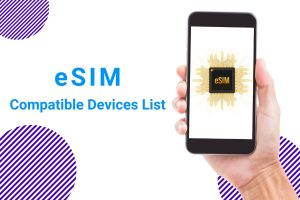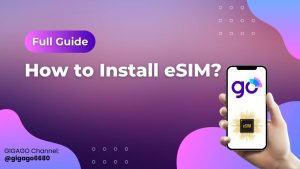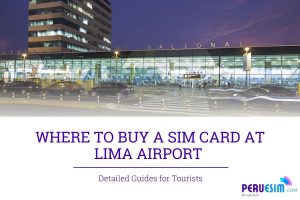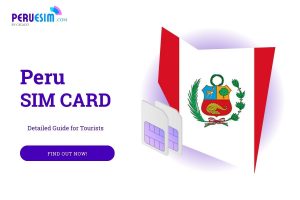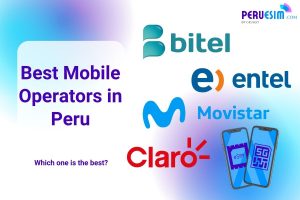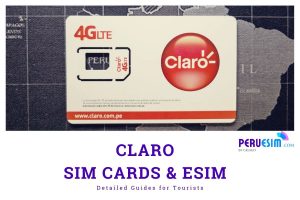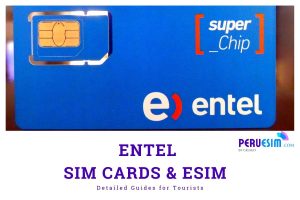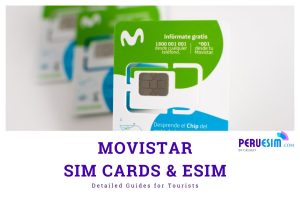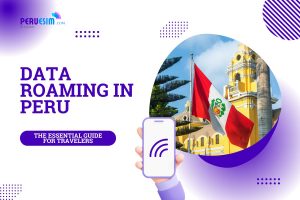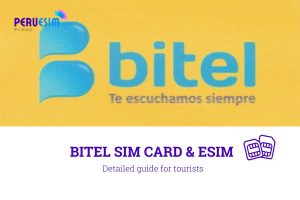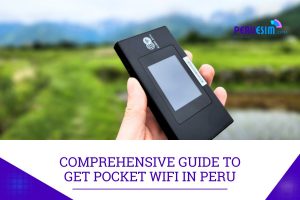Staying connected while exploring the wonders of Peru is easier than ever thanks to the widely available mobile internet in Peru.
Whether you choose a local SIM card, a portable Wi-Fi hotspot, or rely on cafe Wi-Fi, internet access in Peru allows you to navigate new cities, translate menus, book accommodations, share your photos on social media, and stay in touch with family and friends. Having reliable mobile data or internet connectivity ensures a smoother, more informed, and ultimately more enjoyable travel experience.
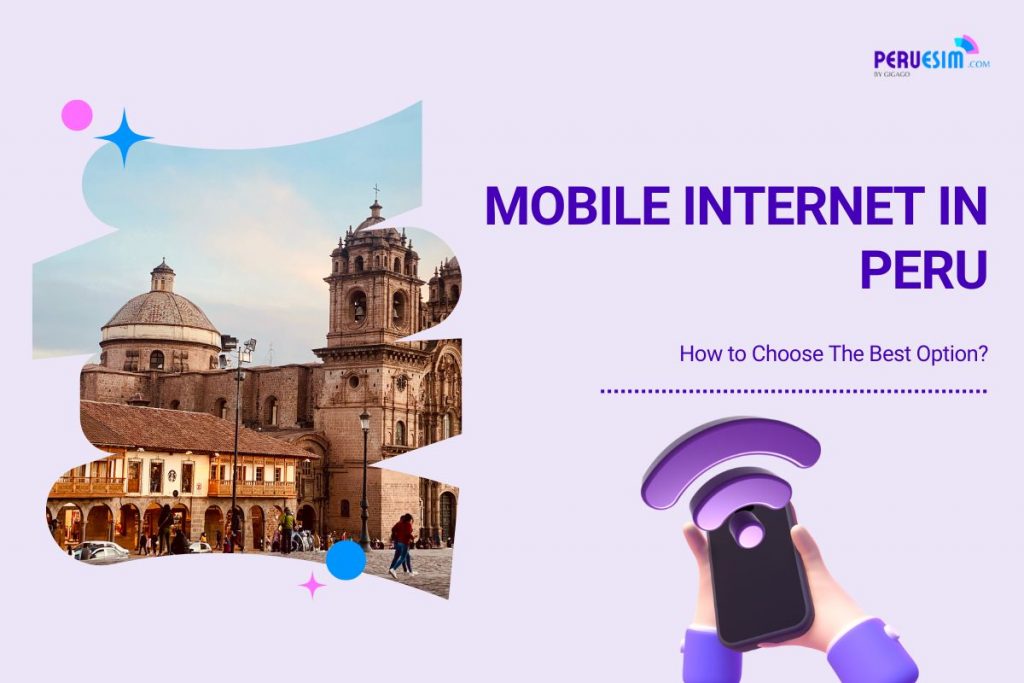
Table of Contents
I. Get Mobile Internet in Peru Easily with These 5 Tips for Tourists
5 ways to get online in Peru for travelers, including Wi-Fi, pocket Wi-Fi, SIM cards, eSIM, and roaming:
1. Peru eSIM: The Digital Solution
eSIMs, or embedded SIMs, represent a significant advancement in mobile connectivity. They are essentially digital SIM cards that are integrated directly into your compatible device, eliminating the need for physical SIM cards. This offers a range of benefits for travelers:
- Convenience: Say goodbye to fiddling with tiny SIM cards and the risk of losing them. With an eSIM, switching between carriers or activating a new plan is as simple as a few taps on your device.
- Instant Activation: Upon arrival in Peru, you can buy & activate your eSIM data plan immediately, saving you valuable time and ensuring you’re connected from the moment you land. Consider using eSIM from peruesim.com for various plans at a reasonable price.
- Multiple Profiles: One of the most powerful features of eSIMs is the ability to store multiple profiles on your device. This allows you to have separate plans for different countries or carriers, making it incredibly convenient for frequent travelers
- Environmentally Friendly: By eliminating the need for physical plastic SIM cards, eSIMs contribute to a more sustainable approach to mobile connectivity.
2. Local Peru SIM Cards: The Traditional Approach
Purchasing a local SIM card in Peru is a popular and often cost-effective way to stay connected. Here’s what you need to know:
Consider our recommendations on where to buy SIM cards in Peru, SIM cards are readily available from various locations throughout Peru:
- Jorge Chávez International Airport (Lima): Upon arrival, you’ll find kiosks and shops selling SIM cards from major local providers like Claro, Movistar, and Entel.
- Mobile Operator Stores: These providers have official stores in cities and towns across Peru, offering a wider selection of plans and assistance with activation.
- Pharmacies and Supermarkets: For added convenience, some pharmacies and supermarkets also sell SIM cards, although the plan options might be more limited.
Connecting to the network:
- Inserting the SIM: Once you’ve purchased a SIM card, insert it into your phone’s SIM card slot.
- APN Configuration: You might need to configure the Access Point Name (APN) settings to connect to the local network. Instructions for this are usually provided with the SIM card or can be found on the operator’s website. Don’t hesitate to ask the vendor for assistance.
- Choosing a provider: Claro, Movistar, and Entel are the main mobile operators in Peru. Compare their plans and coverage to find the best option for your needs.
3. Roaming: The Convenient but Costly Option
Roaming allows you to use your existing mobile plan from your home country while traveling in Peru. While convenient, it comes with significant drawbacks:
- High Costs: Roaming charges in Peru can be exorbitant, especially for data usage. Even seemingly small amounts of data can quickly rack up substantial bills.
- Hidden Fees: Be wary of hidden fees and unexpected charges. Carefully review your roaming plan details and be mindful of background data usage, automatic app updates, and data-intensive activities like streaming.
4. Free Wi-Fi: The Budget-Friendly Choice
Free Wi-Fi is widely available in Peru, offering a budget-friendly way to stay connected:
✨Where to find free Wi-Fi:
- Cafés and Restaurants: Many establishments offer complimentary Wi-Fi to customers.
- Hotels: Most hotels provide free Wi-Fi access, often in both rooms and common areas.
- Airports: Jorge Chávez International Airport and some regional airports offer free Wi-Fi, although it may have time limits or require registration.
- Shopping Malls: Larger shopping malls typically provide free Wi-Fi access.
- Public Libraries: Some public libraries offer free internet access to visitors.
✨Disadvantages and Considerations:
- Security Risks: Public Wi-Fi networks can be vulnerable to security breaches. Avoid accessing sensitive information like online banking or making online purchases while connected to public Wi-Fi. Use a VPN for added security.
- Speed and Reliability: Free Wi-Fi can be slow or unreliable, especially during peak hours or in crowded areas.
- Availability: While increasingly common, free Wi-Fi is not always available, particularly in remote regions or smaller towns.
5. Pocket Wi-Fi: Portable Connectivity
Pocket Wi-Fi devices, also known as portable hotspots, offer a convenient way to create your own private Wi-Fi network:
How to get a Pocket Wi-Fi device:
- Rental: You can rent pocket Wi-Fi devices at the airport, from electronics stores in major cities, or online before your trip.
- Purchase: Purchasing a pocket Wi-Fi device is an option if you travel frequently.
Things to consider: - Battery Life: Ensure the device has sufficient battery life to last throughout your day. Carry a portable charger for extended use.
- Data Limits: Be aware of any data caps or fair usage policies associated with your pocket Wi-Fi plan.
- Coverage: Check the device’s coverage area to ensure it works in the regions you’ll be visiting in Peru.
Rental Costs: Compare prices from different providers to find the best deal.
Return Policy: Understand the return process and any associated fees if you’re renting a device.
By carefully considering these different connectivity options and their respective advantages and disadvantages, you can choose the best solution to meet your individual needs and budget, ensuring a seamless and connected travel experience in Peru. Remember to factor in your data usage, travel style, and budget when making your decision.
II. Budgeting for Mobile Data Costs in Peru
For tourists in Peru, prepaid data is readily available.
- Daily/weekly plans cost S/.1-S/.15 (PEN) for limited data (500MB-3GB).
- Monthly plans range from S/.20-S/.50 (PEN) for 5GB-15GB. Claro, Movistar, Entel, and Bitel are the main providers. Purchase SIM cards at airports or city centers with your passport. Check coverage beforehand and compare provider offers. Some offer tourist-specific plans.
Staying connected during your travels in Peru is essential for accessing travel information, staying in touch with loved ones, and sharing your experiences. With various Mobile Internet In Peru options available, such as free WiFi, pocket WiFi, eSIM, SIM cards, and roaming, you can choose the option that best suits your needs and budget.
